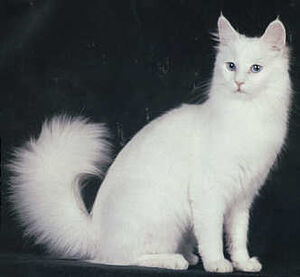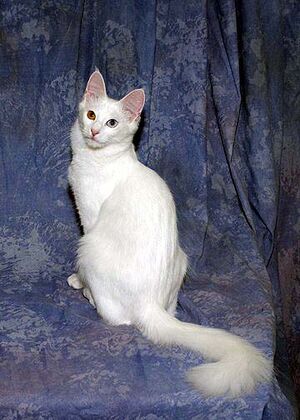
A Pure White Angora
The Turkish Angora is one of the ancient breeds of domestic cat. This breed was a naturally occurring cat breed, with no human selective interaction, having originated in central Turkey, in the Ankara region. The Turkish Angora has a long coat like no other coat, with a sensuously silky and luxurious texture.
Description[]
The Turkish Angora fur was originally white but now comes in many other colors. They have a silky, medium-long length coat with no undercoat and fine bone structure. Although they are known for their shimmery white coat, currently there are more than twenty varieties including black, blue, and reddish fur. They come in tabby and tabby-white, along with smoke varieties, and are in every color other than pointed, lavender, and cinnamon. Eyes may be blue, green, or amber. Sometimes a cat has two different color eyes such as one blue and one amber or green. The W gene responsible for the white coat and blue eye is closely related to hearing ability, and the presence of a blue eye can indicate the cat is deaf to the side the blue eye is located. However, a great many blue and odd-eyed white cats have normal hearing, and even deaf cats lead a very normal life if kept indoors. Some Turkish Angoras with normal hearing love to go outside, and if you have hardwood floors inside, the Turkish Angora will be agreeable to spin in donuts on the floor. Ears are pointed and large, eyes are almond shaped and the head is massive with a two plane profile. Another characteristic is the plumed tail, which is often carried upright, perpendicular to the back.
History[]
Like all domestic cats, Turkish Angoras descended from the African wildcat or Felis silvestris lybica. The mountainous regions of Eastern Anatolia isolated cats brought by traders from Egypt, and through inbreeding and natural selection they developed into longhaired breeds like the Turkish Van and the Turkish Angora.

An Odd-Eye Turkish Angora
Longhaired cats were imported to Britain and France from Asia Minor, Persia and Russia as early as the late 16th century. However there are indications that they appeared in Europe as early as the 14th century due to the Crusades. The Turkish Angora was used, almost to the point of extinction, to improve the coat on the Persian. The Turkish Angora was recognized as a distinct breed in Europe by the 17th century.
Then in the 20th century, the Turkish government and the Ankara Zoo began a meticulous breeding program to protect and preserve what they considered a national treasure. This protected the pure white Turkish Angoras with blue and amber eyes. The program continues today. The zoo particularly prized odd-eyed Angoras which are the Turkish Angoras with one blue eye and one amber eye. The Turkish Angora was brought to the United States in 1963 and accepted as a championship pedigreed breed in 1973 by the Cat Fanciers' Association. However, until 1978 only white Angoras were recognized. Today, all North American registries accept the Turkish Angora in many colors and patterns. While numbers are still relatively small, the gene pool and base of fanciers are growing.They look so much like Turkish Van Cats but they are not.
